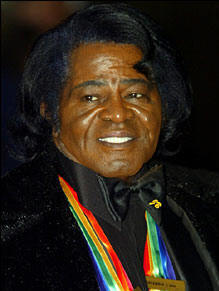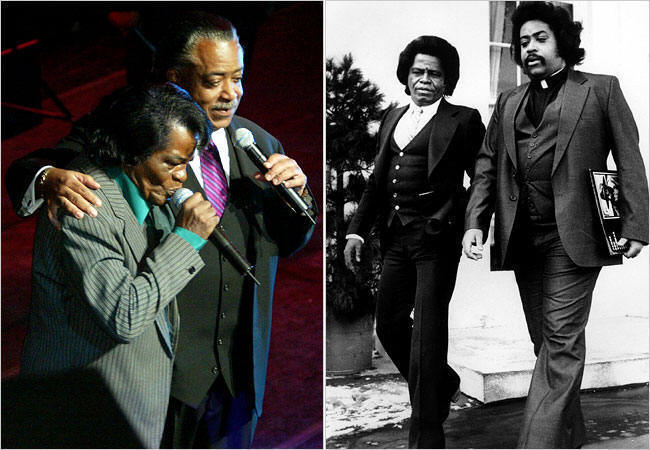






(Photos: At the 2003 Kennedy Center Honors
Awards/Associated Press; performing in Westbury, New York in 1972/Associated
Press; dancing in Washington, D.C. in 2001/Shawn Thew, Agence France Presse/Getty
Images; and still stepping strong in November 2006 in the U.K./Getty Images)
printer-friendly
James Brown, a singular, unique figure on the
world's stage of music for five decades, died on Christmas Day 2006 at the age
of 73.
Mr. Brown's influence on music and on thousands of artists was beyond legendary.
He was the architect of soul sound and defined it for three generations.
Often imitated and never ever duplicated, James Brown touched millions the world
over and warmed the hearts of, and aided people in need everywhere, most notably
during the severely troubled 1960's in the United States when racial injustice
and violence against blacks escalated during the initial Civil Rights Era.
In one significant moment during the 1960's he performed onstage in Detroit
amidst heightened unrest within that city after what had been seen by its
population as an unjustified shooting of an innocent man by police. While
there were calls from many for Brown to postpone the concert because of the
danger of imminent violence, Mr. Brown declined to do so and prevented further
violence from occurring with his performance and his words to the angered
throngs of people in attendance.
His architecture and unique brand of soul, funk, and rhythm and blues carried a
distinctly Afrocentric message of pride and positive affirmation for black
people in America during the 1960's and 1970's with such hit songs as "Say It
Loud (I'm Black And I'm Proud)" and "I Don't Want Nobody To Get Me Nothing (I'll
Open Up The Door And Get It Myself)", inspiring them to be proud and confident
in who they were, even as they were being told by some in state and federal
government and society at large that they were less than men and women.
Mr. Brown dubbed himself "Soul Brother Number One" and the "Godfather Of Soul"
-- and he more than lived up to those titles.
James Brown inspired and influenced so many people in all walks of life.
In politics -- where he became godfather to the Reverend Al Sharpton when the
reverend was a young boy preacher (for many years Mr. Sharpton has worn his hair
he says, in tribute to Mr. Brown) -- and in the entertainment world -- from The
Beatles, Elvis, Mick Jagger, Janice Joplin, Tom Jones, Prince, Michael Jackson,
Rick James, and The Ramones, to Terence Trent D'Arby, MC Hammer, and Ricky Martin -- they are just a few of among
countless artists and performers the world over -- black, white, Latino, Asian
-- whom he has influenced. The imprint of his music, style, sound, sayings
and grandeur will last for generations to come as the world mourns Mr. Brown's
passing.
James Brown was a tireless perfectionist instrumental in bringing
millions of white fans into the fold of soul music and sound in the 1960's.
In England in particular, where his white fan base exploded (after The Beatles
said they listened to James Brown) and then endured for years to come after
witnessing the show-stopping showman in concerts, he was adored deeply.
His charisma, dynamism, magnetism, populist manner, showmanship and universal
appeal while staying true to his origins (born in the American South in South
Carolina in 1933) and dedication to helping black people in adverse
circumstances won him the respect, adoration of (and criticism by) people the
world over. He toured and performed in almost every part of the planet,
invigorating hearts and souls with his stirring entertainment routines on stage
-- from his shuffling feet, fancy footwork and moonwalk gliding, to his leg
splits and microphone stand drops, spins, slides and cape-covering act -- Mr.
Brown was one of the world's greatest entertainers of all time, if not the
greatest. His energy was phenomenal, often performing back-to-back
three-hour shows in the same city, sometimes several shows in different cities
in the same night, according to one documentary on the soul legend. As
recently as November 2006 he was in the United Kingdom performing (see fourth
photo at the top of this page) at age 73, and was to perform on New Year's Eve
2006 in New York City at B.B. King's in Times Square. Against doctor's
orders, Mr. Brown, who passed from heart failure associated with the pneumonia
he had been admitted to hospital with yesterday, vowed to perform.



Left, black and white photo: James Brown in the
1960's in England. He brought many white music fans into the realms of
soul and R&B with his innovation and unique sound.(Photo:PA)
Right photo: In Los Angeles in 1997 after receiving his own star on the
Hollywood Walk Of Fame. (Photo: Vince Bucci/Agence France Presse-Getty
Images)
Photo immediately above this caption: In 2004 with his godson the Reverend
Al Sharpton, who wears his hair in salute and tribute to Mr. Brown, who became
the reverend's surrogate father from an early age; and with the reverend outside
the White House in 1982. (2004 photo: Dith Pran/The New York Times; 1982
photo: Scott Applewhite/AP)
If Chuck Berry and Little Richard have been
acknowledged as the kings and architects of rock and roll music, then the
architect of soul was Brown. Even as
he walked through the eras of the music scene constantly shifting, his sound continued to influence
as much today as it did back in the 1950's. Brown once said that everyone
had soul, "whether it's talking, hip-hop, rap, gospel."
To some, Mr. Brown
was a highly controversial figure.
*
*
*
No one is perfect in life.
How do you measure a person's life? What justice can you give it? Is
it in love? In accolades? In riches? In triumph over
adversity? In life's lessons and pains? In the lives of those one
touches?
*
*
*


1966 and 2006: Performing on The Ed Sullivan Show, and at
this year's Grammy Awards (1966 photo: CBS photo archive-Getty Images;
2006 photo: European Pressphoto Agency)
Mr. Brown was endlessly decorated with awards -- he received a Kennedy Center
honor in 2003, got a star on the Hollywood Walk Of Fame in 1997, won numerous
Grammy Music Awards and appeared in such feature films as "The Blues Brothers",
its sequel "Blues Brothers 2000" and "Rocky IV" (in which he sung the highly
popular "Living In America".) Also a songwriter, he wrote countless songs
of his own, as well as for other musicians and for television shows. His
songs appeared in many, many motion pictures, including Robert De Niro's 1993
film "A Bronx Tale", the song "It's A Man's Man's Man's World" echoing through
that film's turbulent moments, a haunting refrain. At one point Mr. Brown
was said to be the most-sampled artist in the world, used in great measure by
rap and hip-hop artists around the globe. Many of the artists sung his
praises in their songs. Mr. Brown had tried to gain royalties from many
rappers but was unsuccessful -- the musicians had sampled such infinitesimal
portions of Mr. Brown's music that it was difficult to apportion any appreciable
royalties from it. Perhaps as an adherence to the philosophy of "if you
can't beat them, join them," Mr. Brown shared the stage on his song "I'm Real"
with the 1980's hip-hoppers Full Force, almost as a tongue-in-cheek rejoinder to
the rappers and hip-hop artists who would sample his music. "All you
copycats out there, get off of my tip, 'cause I'm James Brown with the Force . .
. ain't takin' no lip," he sung in the opening lines of that song.
Eddie Murphy, known as a huge fan of James Brown, has referenced the Godfather
Of Soul in several movies, including "Dreamgirls", which coincidentally expands
its release in North America today. In the film, Mr. Murphy plays the
character of James "Thunder" Early, a character who is modeled after James
Brown. "I'm the first soul brother," Mr. Murphy's character says during
the film. In fact during Brown's song "Living In America" the famous
innovator cries out, "Eddie Murphy, eat your heart out!"
Fortunately enough, this editor had the momentary chance to share time and space
with Mr. Brown while at one of his concerts in the 1990's. He moved,
grooved and messaged as well then as he did back in the 1960's and 70's. A
presence that made minds shine and hearts soar, he lightened the burdens of
millions, challenged people to believe in themselves, addressed and confronted
the social conditions that still deeply blight nations the world over and spoke
truth to those within the corridors of power -- many of whom invited him to
their gatherings, ceremonies, dinners and feted him in admiration and
appreciation for all he had done.
James Brown was dynamic, majestic, magnificent and profound. A man of
immense self-confidence, pride and determination, he energized, entertained and
enraptured countless millions for fifty years.
In short, he was, and will forever remain, an irreplaceable genius.
-- Omar P.L. Moore
The Editor, The Popcorn Reel

December 25, 2006: New York City. Members
of the public outside the B.B. King theater, where James Brown was to perform in
concert on New Year's Eve, pay their respects by signing a promotional placard
for the concert. Mr. Brown was said to have died from heart failure
brought on by pneumonia. (Photo: James Estrin/The New York Times)
Originally published December 25, 2006









